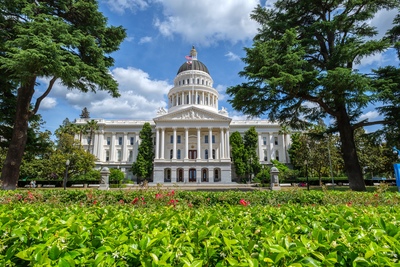
Technology & Privacy
Here's What You Need To Know About Data Center Policy Trends
November 4, 2025 | Morgan Scarboro
February 16, 2022 | Billy Culleton
-5c0182-1200px.jpeg)
Key Takeaways:
Everyone is talking about electric vehicles (EVs) these days. Global sales of battery-powered and plug-in hybrid EVs have risen steadily over the past ten years with nearly every carmaker preparing to convert their fleet to all-electric in the near future.
State lawmakers are also looking to help spur the growth of EVs as states double down on their commitment to transition to cleaner sources of energy. Electric vehicles play a critical part in states’ clean energy policies with forty-five states and D.C. already offering some form of financial incentive for purchasing EVs either through tax credits or rebates.
Last November, President Biden signed the bipartisan Infrastructure Investment and Jobs Act (IIJA) providing, among other provisions, $7.5 billion for states and localities to build out the nation’s EV charging station network. Soon, the newly created Joint Office of Transportation and Energy will publish guidance on how federal funds can be used to build out charging stations across the country. States seeking funding for charging stations will need to submit a plan for approval detailing how they intend to spend the money.
In the meantime, many states still face questions on how to handle a large number of EVs on their roads. Are some state policies risking spurring the transition too quickly for the private sector to actually accommodate? Who is allowed to own and operate charging stations and how will drivers be charged for using roadways if they’re not paying gas taxes? Below are just a few issues state legislators will likely face in the following years on EVs.
In most states, investor-owned public utilities are the main providers of electricity to residents. EV charging stations, however, can essentially be placed anywhere, opening up the opportunity for homeowners, traditional gas stations, convenience stores, retailers, and commercial and residential building operators to offer charging stations for private or public use.
While experts agree that public utilities will play a major role in shaping where stations are built, states differ on whether non-utility owned charging stations can resell electricity to drivers. Forty states currently do not consider third-parties who sell electricity to EV drivers as utilities whereas the remaining ten states would regulate them as such.
During the 2021 legislative session, North Dakota and Texas became the latest states to exempt charging stations from being regulated as a utility with the enactment of new legislation (ND SB 2091 and TX SB 1202). In Georgia, lawmakers introduced a bill (GA HB 776) that would allow existing charging station owners to not be regulated as a public utility.
The price per gallon of gasoline is the national standard for comparing the cost of gas in different parts of the country. For the price of charging an EV, however, the unit of cost depends on the state in addition to the going rate of electricity. In most states, drivers are charged by the kilowatt-hour (kW/hr), while in others, a charging session may be measured by minutes.
In Wisconsin, a couple of bills introduced last year (WI AB 588 & WI SB 573) would allow anyone to sell electricity for EVs by the kilowatt hour, essentially preventing utilities from restricting their customers from selling electricity to EV drivers. A bill introduced in Indiana (HB 1221) would mandate any person selling electricity for the purpose of EV charging to charge on the kilowatt hour sold.
One issue not directly linked with the actual technology of electric vehicles are laws governing direct-to-customer sales. Companies like Tesla and Rivian have challenged the traditional car buying experience by offering customers the ability to buy directly through the manufacturer and not through a dealership.
In 2014, Michigan Governor Rick Snyder signed legislation (HB 5606) that required carmakers to only sell through franchised dealers. Tesla sued the state of Michigan in 2016 over the state’s refusal to allow direct-to-customer sales. The state, home to America’s three largest carmakers, reached an agreement with the company in early 2020 to allow Tesla to sell directly to customers in Michigan.
Currently, seventeen states ban direct-sales of cars while an additional nine states prohibit all new direct-sales, grandfathering in carmakers that already sell direct-to-customer. In Georgia, legislation (SB 389) under debate, which would allow consumers to buy directly from manufacturers, has pitted the state’s auto dealers association and the direct-to-customer EV manufacturers against each other.
While electric vehicles account for less than two percent of the cars on the road today, state lawmakers realize that as the number continues to increase, the financing of future transportation projects is under serious threat. Under the current system, drivers contribute to the maintenance and construction of the roadways by paying a gas tax at the pump. As more consumers and public transportation fleets transition to EVs, fuel tax revenue will continue to dwindle.
States have begun to prepare for this wave by charging annual fees for plug-in electric vehicles, 28 states so far. The fees range from Colorado’s annual fee of $50 for full-electric and plug-in hybrid vehicles while Georgia is on the high end with a $200 per year registration fee.
Many states are even experimenting with user fees like Vehicle Miles Traveled (VMT) or Mileage-Based User Fees (MBUF) as an alternative to fuel taxes. The Oregon Department of Transportation launched a pilot program in 2015 that gave 5,000 volunteers the opportunity to pay 1.5 cents per mile driven in exchange for a rebate on gas tax paid at the pump. As more drivers make the switch to purchase electric, expect more states to explore different ways to charge drivers fees for using roadways.

November 4, 2025 | Morgan Scarboro

October 27, 2025 | Billy Culleton

October 9, 2025 | Bill Kramer